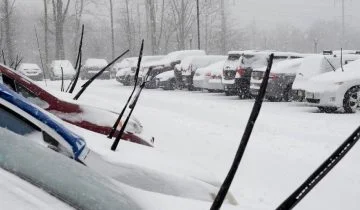During the winter season, it’s not uncommon for wiper blades to freeze and stick to the windshield. This can be a frustrating and potentially dangerous issue for drivers, as it can impair their visibility and compromise their safety on the road.
There are a few factors that can contribute to wiper blades freezing and sticking to the windshield. One common cause is moisture, which can accumulate on the blades and freeze in low temperatures. Another factor is the type of wiper blades being used; some materials are more prone to freezing than others.
Leaving your wiper arms up during winter will help prevent freezing and stick to the windscreen, it’s true but you’re actually doing more harm than good. When your wiper arm is lifted from the windscreen, the wiper arm spring is stretched, leaving your wiper arm in this position for long periods of time can reduce the wiper arm pressure causing the wiper to miss gaps when wiping.
Consequence of Having a Frozen Wiper Blade
The consequence of having a frozen wiper blade can be more than just a minor inconvenience; it can significantly impact a driver’s visibility and safety on the road. When wiper blades freeze, they lose their flexibility and ability to effectively clear the windshield. This can lead to a range of issues that compromise driving conditions and increase the risk of accidents.
First and foremost, a frozen wiper blade can obstruct the driver’s view, creating a hazy or distorted windshield that makes it difficult to see the road ahead, other vehicles, pedestrians, and potential hazards. This impaired visibility reduces reaction time and increases the likelihood of collisions, particularly in situations where split-second decisions are crucial.
Additionally, attempting to use frozen wiper blades can cause undue strain on the wiper system, potentially leading to mechanical damage. The rubber or silicone material of the blades can become brittle in freezing temperatures, leading to cracks, tears, or even detachment from the wiper arm. This not only renders the wipers useless but also poses a risk of scratching or damaging the windshield’s surface.
In severe cases, attempting to operate frozen wiper blades might overload the wiper motor, which can lead to electrical issues or motor burnout. This can result in costly repairs and further contribute to the safety risks associated with compromised visibility.
So How Can You Prevent Wiper Blades From Freezing?
To prevent wiper blades from freezing and sticking to the windshield, there are several steps drivers can take.
One of the most effective measures is to park the vehicle in a garage or covered area to prevent snow and ice from accumulating on the windshield and wiper blades. If this is not possible, using a windshield cover or tarp can also help to protect the wiper blades.
Another preventive measure is to keep the windshield and wiper blades clean and free from debris. Snow, ice, and dirt can all contribute to the freezing and sticking of wiper blades. Regularly cleaning the windshield and wiping down the wiper blades with a cloth can help to prevent this issue.
If wiper blades do freeze and stick to the windshield, it’s important to avoid using force to free them, as this can damage the blades or the windshield. Instead, drivers can try using a de-icing solution or warm water to melt the ice and free the blades. Additionally, turning on the vehicle’s defrost setting and allowing the windshield to warm up can also help to loosen the blades.
Quick Proper Maintenance Tips for WIper Blades
Proper maintenance of wiper blades is essential for ensuring clear visibility and safe driving, especially during adverse weather conditions. Here are some quick tips to help you keep your wiper blades in good condition:
- Clean Windshield: Regularly clean your windshield to remove dirt, grime, and debris that can accumulate and affect the performance of your wiper blades.
- Gentle Use: Avoid using your wiper blades on a dry windshield. This can cause unnecessary wear and tear on the blades and may lead to streaking.
- Regular Inspection: Inspect your wiper blades for signs of wear, such as cracks, tears, or uneven edges. If you notice any damage, it’s time to replace the blades.
- Clean the Blades: Periodically wipe down the rubber or silicone portion of the wiper blades with a damp cloth to remove dirt and grime.
- Check Wiper Fluid: Ensure that your windshield washer fluid reservoir is filled with suitable fluid for the weather conditions. Using a winter formula in colder months will help prevent freezing and keep your windshield clean.
- Replace as a Pair: When it’s time to replace your wiper blades, consider replacing them as a pair. Like if you’re planning to replace a Honda Civic 2017-2023 (FK2) Wiper blades, buy both wipers, not just a piece of it..
- Don’t Use Wipers to De-Ice: Avoid using your wiper blades to remove ice or heavy snow from the windshield. Use an ice scraper instead.
- Keep Windshield Clean: Keep the area around your windshield wiper mechanisms clean from snow, ice, and debris.
- Store Properly: If you’re storing your vehicle for an extended period, make sure to park it with the wiper blades lifted away from the windshield to prevent them from sticking.
Proper maintenance of wiper blade can lead to improved visibility, better performance, and increased safety on the road. It can also help to extend the lifespan of the wiper blades and save drivers money in the long run by avoiding costly repairs or replacements.
Always check your wiper blades to make sure they are operating correctly and effectively. If you find it’s time for new blades, you can select your wiper blades from the form below.

